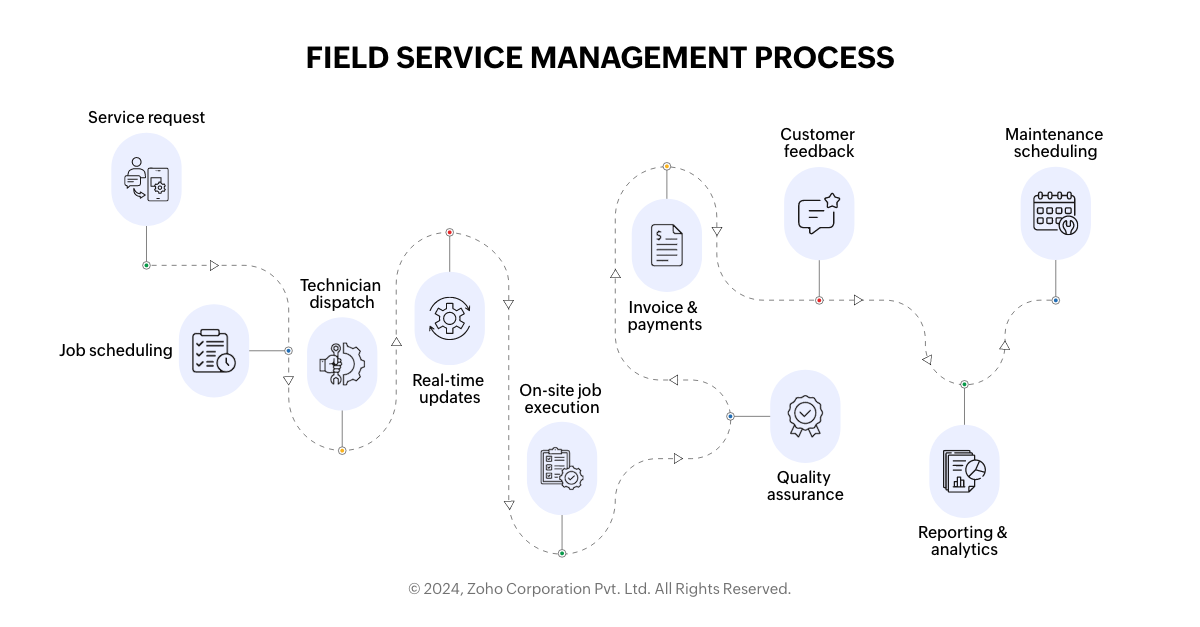- HOME
- Workflow automation
- 5 ways field service management software augments your field service operations
5 ways field service management software augments your field service operations
- Last Updated: July 30, 2024
- 532 Views
- 8 Min Read

Field service management (FSM) is experiencing remarkable growth and transformation in the present decade. According to G2's prediction, the FSM market is projected to grow substantially by 2029. Despite a notable 75% labor power shortage, the FSM market is still expected to hit a profit of $8.59 billion. This represents a robust compound annual growth rate (CAGR) of 11.70% during the forecast period. This exponential growth highlights the increasing reliance on FSM solutions to enhance business efficiency and customer satisfaction.
Field service refers to services provided by field service technicians at the customer's site rather than at the company's premises. This model is prevalent in industries such as manufacturing, high-tech, and healthcare technologies. Some of the trending technologies—IoT, AR and VR, cloud computing, and AI—are also used in field service management software today.
In these sectors, the need for on-site installation or repair services is critical to ensuring the smooth operation of complex systems and equipment.
What is field service management?
Field service management (FSM) is about managing workers and equipment used at customer locations instead of the company's site. It includes organizing tasks like installing, maintaining, and repairing equipment.
Managing field services includes scheduling, dispatching, work order management, and tracking worker activities. Using field service management software helps make these tasks more accessible and efficient for businesses. This substantially provides real-time updates, better scheduling, and seamless communication.
Types of field services
Installation
Installation involves setting up equipment or systems at the customer's location, ensuring everything works properly and meets standards. This includes assessing the site, assembling the equipment, testing it, and providing basic training.
You may have noticed how new HVAC systems are installed in residential and commercial areas. A technician comes over, assesses where everything should go, assembles and sets up the equipment, runs a few tests to ensure it's working perfectly, and then walks you through how to use the thermostat. In this step, the equipment is installed in that area.
Maintenance
Maintenance is the regular upkeep of equipment or systems to keep them working correctly and prevent issues. It includes routine inspections, preventive actions like cleaning and lubrication, and optimizing performance to ensure reliability.
Another example is elevator maintenance at some apartments. A service team shows up every few months to give them a thorough check-up. They clean and lubricate all the parts, make sure everything is running smoothly, and address any potential issues before they become big problems. It's all about keeping things running without a hitch.
Repair
Repair involves fixing problems with equipment or systems to restore full functionality. This includes diagnosing issues, replacing or repairing faulty parts, testing to ensure the fix works, and informing the customer about the repair and preventive steps.
Picture this: The conveyor belt at a manufacturing plant suddenly stops working. A technician arrives, quickly diagnoses the problem as a faulty motor, replaces it, tests the belt to ensure it's back in action, and then explains to the plant manager how to avoid similar issues down the line.
An introduction to the field service management software
Field service management software is an essential tool for modern businesses that rely on field service operations. It manages everything from the initial service request to the final invoice payment. It also provides real-time updates and better resource management, leading to increased efficiency and customer satisfaction.
For example, in a manufacturing company, field service management software can manage activities from service requests to payments. When a machine at a customer site needs repair, the software helps schedule and dispatch a technician with the right skills. It tracks the technician's activities and ensures they arrive on time. The field service technicians can update the job status in real-time, which the field service managers can monitor. Once the job is completed, the software generates an invoice and processes the payment. This streamlines operations, reduces errors, and improves communication.
5 ways a FSM software adds value to your business
Here are the five significant benefits of field service management software that assists you in your field service operations to the core.
1. Customer service and technician productivity
Real-time updates and notifications
Field service management software provides customers with timely updates about their service requests. They receive notifications regarding appointment confirmations, technician arrivals, and job completion. This transparency keeps customers informed and satisfied, reducing the uncertainty and wait times often associated with field services.
Access to customer history
Here, the technicians can access detailed customer histories of separate orders. This information includes past service records/customer data, previous issues, and specific customer preferences. This enables the technicians to address problems more effectively and personalize the service experience.
Mobile tools for technicians
Field service management software equips technicians with mobile apps that facilitate real-time communication, job updates, and access to technical support. The field service technicians could access the live inventory status of the requests made remotely. This connectivity ensures that technicians have all the resources they need at their fingertips. It enhances their ability to resolve issues quickly and efficiently.
2. Cost control and salary computation
Automated scheduling and dispatching
FSM software automates technician scheduling and dispatching, eliminating manual errors and reducing administrative overhead. This ensures that the right technician is assigned to the right job at the right time, optimizing resource allocation.
Job tracking and reporting
The software tracks each job's progress from initiation to completion. This tracking provides accurate data on the time and resources spent on each task, which is essential for calculating salaries and managing expenses.
Expense management
Effective field service software has modules that help in monitoring and controlling operational expenses. By providing detailed insights into travel costs, equipment usage, and labor hours, businesses can identify areas where costs can be reduced without compromising service quality.
Minimized downtime and travel expenses
Optimized scheduling and routing not only improves technician productivity but also reduces downtime and travel expenses. Technicians spend less time on the road and more time performing billable tasks, leading to better financial outcomes.
3. Error reduction and proactive reaction
Precision and accuracy
One of the significant benefits of field service management software is its ability to minimize human errors by automating many routine tasks. Technicians receive precise instructions and access to real-time data, reducing the likelihood of mistakes during service delivery.
Proactive maintenance scheduling
The software can predict potential issues by analyzing historical data and usage patterns. This predictive capability allows businesses to schedule maintenance before problems escalate, preventing costly breakdowns and extending the life span of equipment.
Immediate problem resolution
With real-time data and access to a knowledge base, technicians can quickly diagnose and resolve issues on-site. This immediate resolution reduces the need for follow-up visits and enhances customer satisfaction.

4. Organizing job history and scheduling
Comprehensive job histories
Field service management software maintains detailed records of all service jobs, including issues encountered, solutions implemented, and customer feedback. This comprehensive history helps diagnose recurring problems and assign service allotment to the available technician.
Automated documentation
Field service management software automatically documents all service activities, including technician notes, parts used, and time spent. This thorough documentation ensures accurate customer data, which is crucial for compliance and quality control.
Skill-based scheduling
The software can filter field service technicians based on their skills and qualifications, ensuring that the most suitable technician is assigned to each job. This skill-based scheduling improves service quality and customer satisfaction.
Geographic optimization
Field service management software optimizes scheduling by considering the geographic locations of customers and technicians, reducing travel time, and increasing the number of jobs completed each day.
Resource planning
This software aids in better resource planning by providing insights into technician availability, workload distribution, and job priorities. This planning capability ensures that resources are utilized efficiently and service commitments are met.
5. Multiple system integration
CRM integration
Field service management software integrates with CRM systems to ensure that customer information is up-to-date and accessible. This integration enhances CRM by providing a 360-degree view of customer interactions and service history.
ERP integration
Integration with ERP systems allows for streamlined operations across different departments. This connectivity ensures that service data flows seamlessly between field operations, inventory management, and finance, improving overall business efficiency.
Accounting software integration
Field service management software can integrate with accounting systems to automate billing and financial reporting. This integration reduces manual data entry, minimizes errors, and ensures accurate financial records.
An overview of the field service management automation process
Step 1: Service request and estimation
An optimal field service management software enables customers to submit service requests through multiple channels, such as online portals, mobile apps, or customer service centers.
Field service management software generates accurate service estimates, which customers can review and approve with a single click. This streamlined process enhances transparency and speeds up service initiation.
Step 2: Job scheduling
The software breaks down service requests into smaller tasks and assigns them to the appropriate field agents. Jobs are scheduled based on technician skills and geographic locations, ensuring optimal resource utilization.
Advanced mapping tools optimize travel routes, reducing travel time and increasing the number of jobs completed.
Step 3: Technician dispatch
Once the job is scheduled, the software dispatches the right technician to the location. Technicians receive all job details, customer information, and necessary tools on their mobile devices, ensuring they are well prepared for the task.
Step 4: Real-time updates
Technicians can update their job status in real-time using their mobile devices. This allows the field service manager to track progress and make adjustments if necessary. Customers also receive real-time updates, keeping them informed throughout the process.
Step 5: On-site job execution
Field service technicians log timesheets and upload photos through a mobile app, providing real-time updates on job progress. Field service management software generates detailed service reports, which can be shared with customers for approval.
Customers can sign off on completed work, ensuring satisfaction and quality control. This process also addresses customer expectations.
Step 6: Quality assurance
After the job is completed, a quality check ensures that all work meets the required standards. Technicians can document their work with photos and notes, providing a clear record of what was done.
Step 7: Invoice and payments
Field service management software generates invoices from work orders easily, facilitating prompt billing.
Customers can make payments online or offline, and the software tracks these transactions for accurate financial reporting. Integration with accounting systems ensures that all financial data is accurately recorded and reported.
Step 8: Customer feedback and follow-up
Customers are encouraged to provide feedback on the service they receive. This feedback is crucial for continuous improvement and helps identify areas for enhancement.
Step 9: Reporting and analytics
The software generates comprehensive reports on various aspects of field service operations, such as technician performance, job completion times, and customer satisfaction. These insights help businesses make informed decisions and optimize their processes, increasing customer satisfaction.
Step 10: Maintenance scheduling
The software can automatically schedule regular maintenance based on historical data and usage patterns, ensuring equipment is always in top condition and reducing the likelihood of unexpected breakdowns.
By automating these processes, field service management software significantly enhances efficiency, reduces errors, and improves overall customer satisfaction.

Gain a competitive advantage on your business with AppCreator
Manage Engine AppCreator is a low-code platform that helps you build field service management solutions with minimal coding. This low-code platform benefits organizations handling the entire field service management process on paper. AppCreator assists in creating a robust solution that helps businesses manage their field service operations efficiently. By utilizing the power of automation, real-time data, and seamless integration, AppCreator helps field service companies enhance customer satisfaction, reduce operational costs, and improve overall productivity.
Adopting AppCreator for your field services needs can revolutionize your business by streamlining operations, enhancing customer satisfaction, and providing valuable insights for continuous improvement. As the usage of field service management software continues to expand, companies that adopt these technologies will build a positive reputation for their efficient services in their respective industries.



